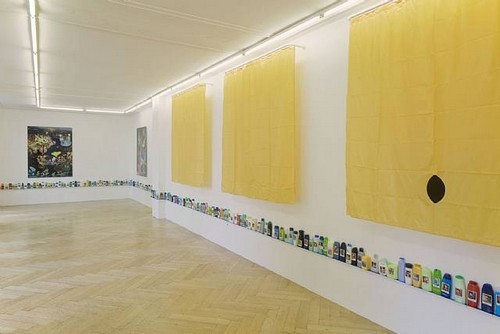Peter Z. Herzog
27 Aug - 15 Oct 2009
PETER Z. HERZOG
''Hammam'/'Bathcare'/'Psycho'/Kosmologie'
Aug 27 - Oct 15, 2009
Opening reception: Wednesday, August 26, 5–8pm
at Galerie Susanna Kulli, Dienerstrasse 21, CH-8004 Zürich
Peter Z. Herzog, who was born in Basel in 1950 and lives in Zurich, spent extended stays in Paris, Vienna, and Berlin. In 2005, he was awarded the highly renowned Art Prize of the canton of Zurich; a well-deserved and nonetheless surprising honor for a quiet, pensive, and reflective observer who has consistently withstood the mainstream and renounced the fast-paced innovations of our time.
In his work, Peter Z. Herzog incorporates not only objects from postmodern everyday life (with all its political implications) but also elements from the traditions of other cultures and from history. He frequently breaks up the forms of these objects, moving toward amorphousness and operating in the unforeseeable: the original.
“‘Hammam’/‘Bathcare’/‘Psycho’/‘Cosmology’”—thus Herzog’s headline above the design for his current exhibition at Galerie Susanna Kulli.
Herzog specializes in the reuse of materials, and the recontextualization it entails. “I am not interested in carrying an aesthetic pleasure to extremes. I am interested in trans-cultural contexts,” Herzog said in a conversation with Stefan Banz at Galerie Susanna Kulli, gesturing toward the manifold interdependencies within the macrocosm on which his art focuses. The zones of artistically expanded consciousness he creates are at once “individual, turbulent, [and] explosive,” thus Herzog. His works allow the beholder to trace entire tangles of associations.
An army of empty shower cosmetics containers dances light-footedly on blue adhesive tape along the walls; three yellow shower curtains offer nothing to the viewer’s gaze but three black holes, beckoning him to pull them aside. The cosmetics containers can be read as the sort of concealed bombs terrorists would use, as the media remind us ever more frequently; by alluding to the birth of Venus from the foam of the sea, they also suggest that we try to place them in the art-historical tradition. The curtains, for their part, play with the fluid transitions between interior and exterior, between unconscious and conscious.
Discussions of Herzog’s work often draw on the concept of “rhizomatic structures” as delineated by Deleuze and Guattari. His works are indeed shaped not by hierarchic growth but by a riotous proliferation with unchecked interconnections. It is no surprise that Herzog would name Hieronymus Bosch’s ‘Garden of Earthly Delights’ with its, thus the artist, “rampant heterothematicity” as a source of inspiration.
Besides such impetuousness, however, there is also a poetic component that defines the arrangement of colors and forms. Herzog describes black as an “entity or ‘appearance’ that swallows all ‘other’ colors,” whereas yellow is the “color of ‘communication’ and ‘madness’ (van Gogh!).” Contrasts, it is well known, heighten the effect, and so the beholder is at first ineluctably attracted by a dark maelstrom before embarking, once he is cast back upon himself, on an intense process of interrogating this complex ensemble.
''Hammam'/'Bathcare'/'Psycho'/Kosmologie'
Aug 27 - Oct 15, 2009
Opening reception: Wednesday, August 26, 5–8pm
at Galerie Susanna Kulli, Dienerstrasse 21, CH-8004 Zürich
Peter Z. Herzog, who was born in Basel in 1950 and lives in Zurich, spent extended stays in Paris, Vienna, and Berlin. In 2005, he was awarded the highly renowned Art Prize of the canton of Zurich; a well-deserved and nonetheless surprising honor for a quiet, pensive, and reflective observer who has consistently withstood the mainstream and renounced the fast-paced innovations of our time.
In his work, Peter Z. Herzog incorporates not only objects from postmodern everyday life (with all its political implications) but also elements from the traditions of other cultures and from history. He frequently breaks up the forms of these objects, moving toward amorphousness and operating in the unforeseeable: the original.
“‘Hammam’/‘Bathcare’/‘Psycho’/‘Cosmology’”—thus Herzog’s headline above the design for his current exhibition at Galerie Susanna Kulli.
Herzog specializes in the reuse of materials, and the recontextualization it entails. “I am not interested in carrying an aesthetic pleasure to extremes. I am interested in trans-cultural contexts,” Herzog said in a conversation with Stefan Banz at Galerie Susanna Kulli, gesturing toward the manifold interdependencies within the macrocosm on which his art focuses. The zones of artistically expanded consciousness he creates are at once “individual, turbulent, [and] explosive,” thus Herzog. His works allow the beholder to trace entire tangles of associations.
An army of empty shower cosmetics containers dances light-footedly on blue adhesive tape along the walls; three yellow shower curtains offer nothing to the viewer’s gaze but three black holes, beckoning him to pull them aside. The cosmetics containers can be read as the sort of concealed bombs terrorists would use, as the media remind us ever more frequently; by alluding to the birth of Venus from the foam of the sea, they also suggest that we try to place them in the art-historical tradition. The curtains, for their part, play with the fluid transitions between interior and exterior, between unconscious and conscious.
Discussions of Herzog’s work often draw on the concept of “rhizomatic structures” as delineated by Deleuze and Guattari. His works are indeed shaped not by hierarchic growth but by a riotous proliferation with unchecked interconnections. It is no surprise that Herzog would name Hieronymus Bosch’s ‘Garden of Earthly Delights’ with its, thus the artist, “rampant heterothematicity” as a source of inspiration.
Besides such impetuousness, however, there is also a poetic component that defines the arrangement of colors and forms. Herzog describes black as an “entity or ‘appearance’ that swallows all ‘other’ colors,” whereas yellow is the “color of ‘communication’ and ‘madness’ (van Gogh!).” Contrasts, it is well known, heighten the effect, and so the beholder is at first ineluctably attracted by a dark maelstrom before embarking, once he is cast back upon himself, on an intense process of interrogating this complex ensemble.

